Chiu School: MKTG 1101 - Marketing Mix Analysis of Domino's Pizza
VerifiedAdded on 2022/09/23
|6
|1016
|22
Report
AI Summary
This report provides a comprehensive marketing mix analysis of Domino's Margherita Pizza, covering key aspects such as product strategy, product classification, and the product life cycle stages. It delves into Domino's branding strategies, highlighting their approach to building brand equity. The analysis further examines the pricing objectives, strategies, and tactics employed by the company for its specific product, as well as the factors considered in pricing. Additionally, the report explores Domino's distribution coverage strategy, offering a holistic view of the company's marketing efforts. The report is structured to meet the requirements of the MKTG 1101 assignment, providing detailed explanations and examples to illustrate the marketing concepts discussed.
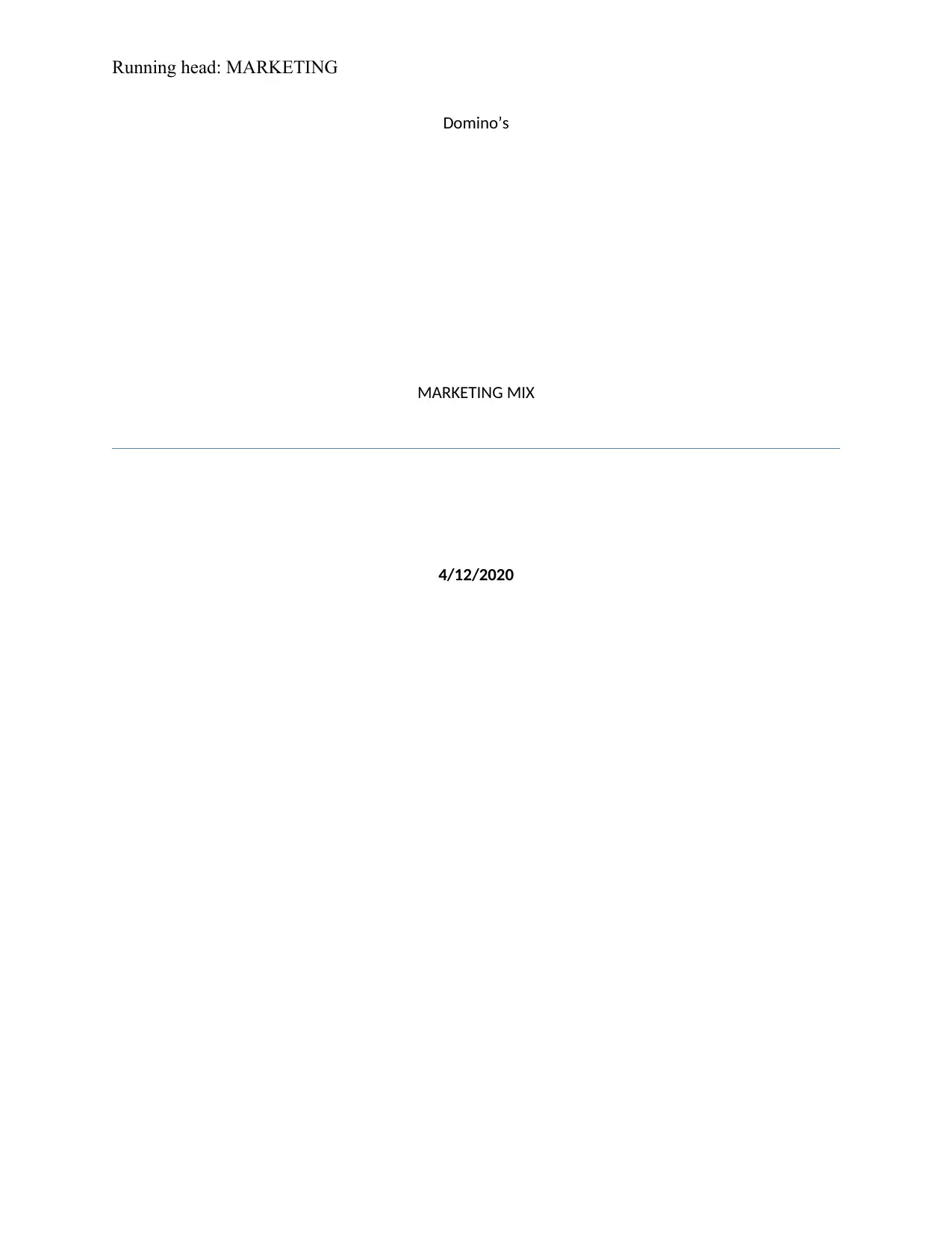
Running head: MARKETING
Domino’s
MARKETING MIX
4/12/2020
Domino’s
MARKETING MIX
4/12/2020
Paraphrase This Document
Need a fresh take? Get an instant paraphrase of this document with our AI Paraphraser
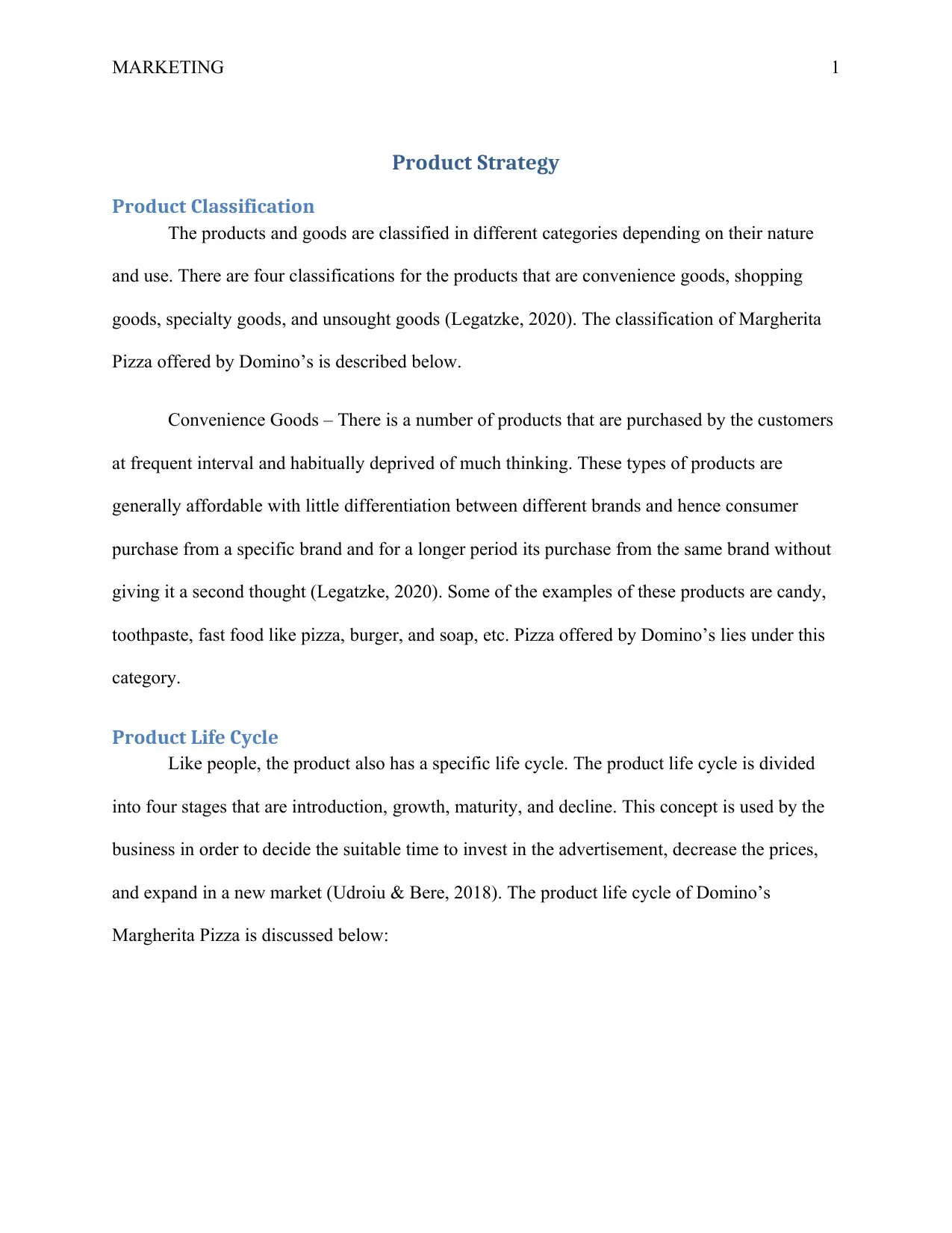
MARKETING 1
Product Strategy
Product Classification
The products and goods are classified in different categories depending on their nature
and use. There are four classifications for the products that are convenience goods, shopping
goods, specialty goods, and unsought goods (Legatzke, 2020). The classification of Margherita
Pizza offered by Domino’s is described below.
Convenience Goods – There is a number of products that are purchased by the customers
at frequent interval and habitually deprived of much thinking. These types of products are
generally affordable with little differentiation between different brands and hence consumer
purchase from a specific brand and for a longer period its purchase from the same brand without
giving it a second thought (Legatzke, 2020). Some of the examples of these products are candy,
toothpaste, fast food like pizza, burger, and soap, etc. Pizza offered by Domino’s lies under this
category.
Product Life Cycle
Like people, the product also has a specific life cycle. The product life cycle is divided
into four stages that are introduction, growth, maturity, and decline. This concept is used by the
business in order to decide the suitable time to invest in the advertisement, decrease the prices,
and expand in a new market (Udroiu & Bere, 2018). The product life cycle of Domino’s
Margherita Pizza is discussed below:
Product Strategy
Product Classification
The products and goods are classified in different categories depending on their nature
and use. There are four classifications for the products that are convenience goods, shopping
goods, specialty goods, and unsought goods (Legatzke, 2020). The classification of Margherita
Pizza offered by Domino’s is described below.
Convenience Goods – There is a number of products that are purchased by the customers
at frequent interval and habitually deprived of much thinking. These types of products are
generally affordable with little differentiation between different brands and hence consumer
purchase from a specific brand and for a longer period its purchase from the same brand without
giving it a second thought (Legatzke, 2020). Some of the examples of these products are candy,
toothpaste, fast food like pizza, burger, and soap, etc. Pizza offered by Domino’s lies under this
category.
Product Life Cycle
Like people, the product also has a specific life cycle. The product life cycle is divided
into four stages that are introduction, growth, maturity, and decline. This concept is used by the
business in order to decide the suitable time to invest in the advertisement, decrease the prices,
and expand in a new market (Udroiu & Bere, 2018). The product life cycle of Domino’s
Margherita Pizza is discussed below:
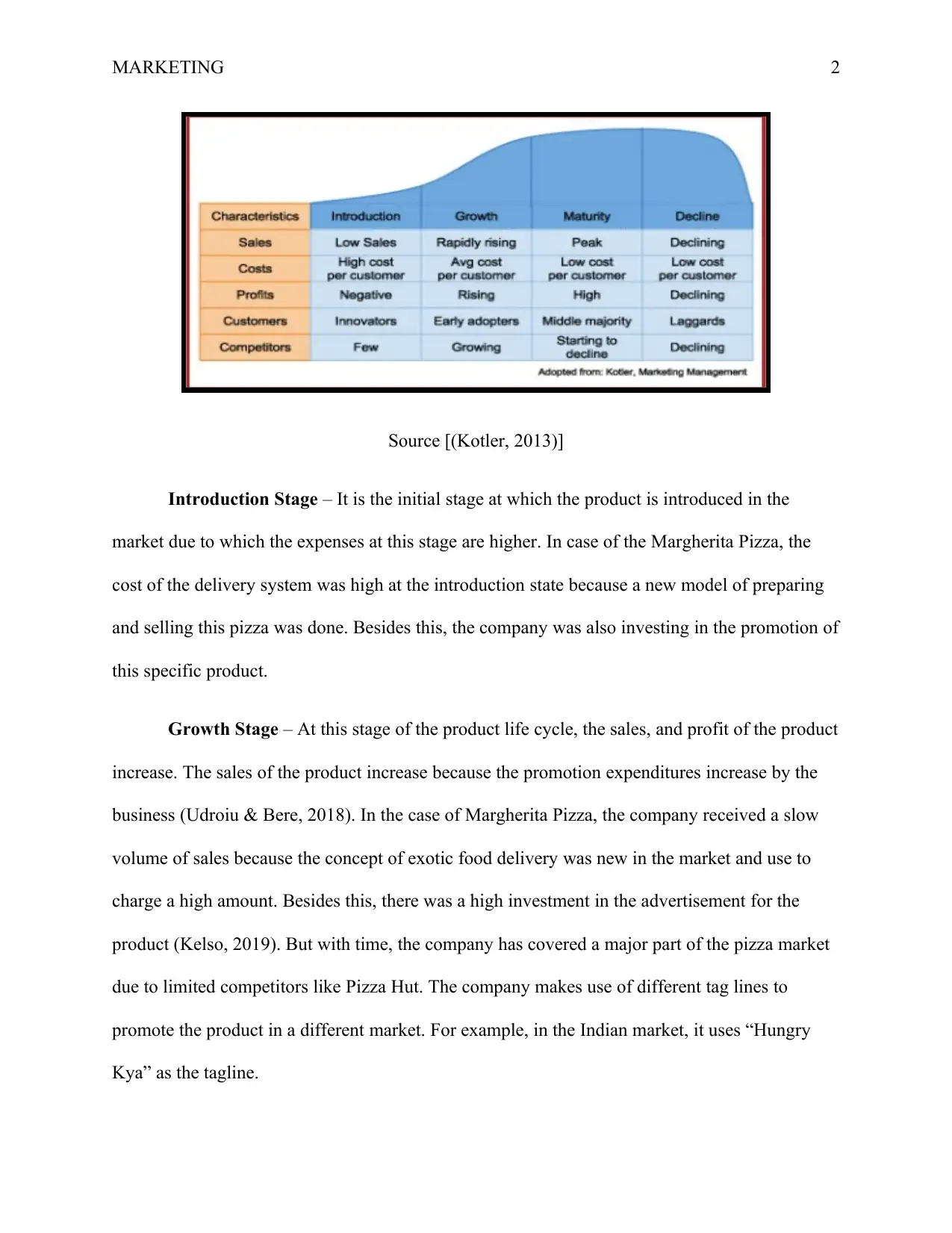
MARKETING 2
Source [(Kotler, 2013)]
Introduction Stage – It is the initial stage at which the product is introduced in the
market due to which the expenses at this stage are higher. In case of the Margherita Pizza, the
cost of the delivery system was high at the introduction state because a new model of preparing
and selling this pizza was done. Besides this, the company was also investing in the promotion of
this specific product.
Growth Stage – At this stage of the product life cycle, the sales, and profit of the product
increase. The sales of the product increase because the promotion expenditures increase by the
business (Udroiu & Bere, 2018). In the case of Margherita Pizza, the company received a slow
volume of sales because the concept of exotic food delivery was new in the market and use to
charge a high amount. Besides this, there was a high investment in the advertisement for the
product (Kelso, 2019). But with time, the company has covered a major part of the pizza market
due to limited competitors like Pizza Hut. The company makes use of different tag lines to
promote the product in a different market. For example, in the Indian market, it uses “Hungry
Kya” as the tagline.
Source [(Kotler, 2013)]
Introduction Stage – It is the initial stage at which the product is introduced in the
market due to which the expenses at this stage are higher. In case of the Margherita Pizza, the
cost of the delivery system was high at the introduction state because a new model of preparing
and selling this pizza was done. Besides this, the company was also investing in the promotion of
this specific product.
Growth Stage – At this stage of the product life cycle, the sales, and profit of the product
increase. The sales of the product increase because the promotion expenditures increase by the
business (Udroiu & Bere, 2018). In the case of Margherita Pizza, the company received a slow
volume of sales because the concept of exotic food delivery was new in the market and use to
charge a high amount. Besides this, there was a high investment in the advertisement for the
product (Kelso, 2019). But with time, the company has covered a major part of the pizza market
due to limited competitors like Pizza Hut. The company makes use of different tag lines to
promote the product in a different market. For example, in the Indian market, it uses “Hungry
Kya” as the tagline.
⊘ This is a preview!⊘
Do you want full access?
Subscribe today to unlock all pages.

Trusted by 1+ million students worldwide
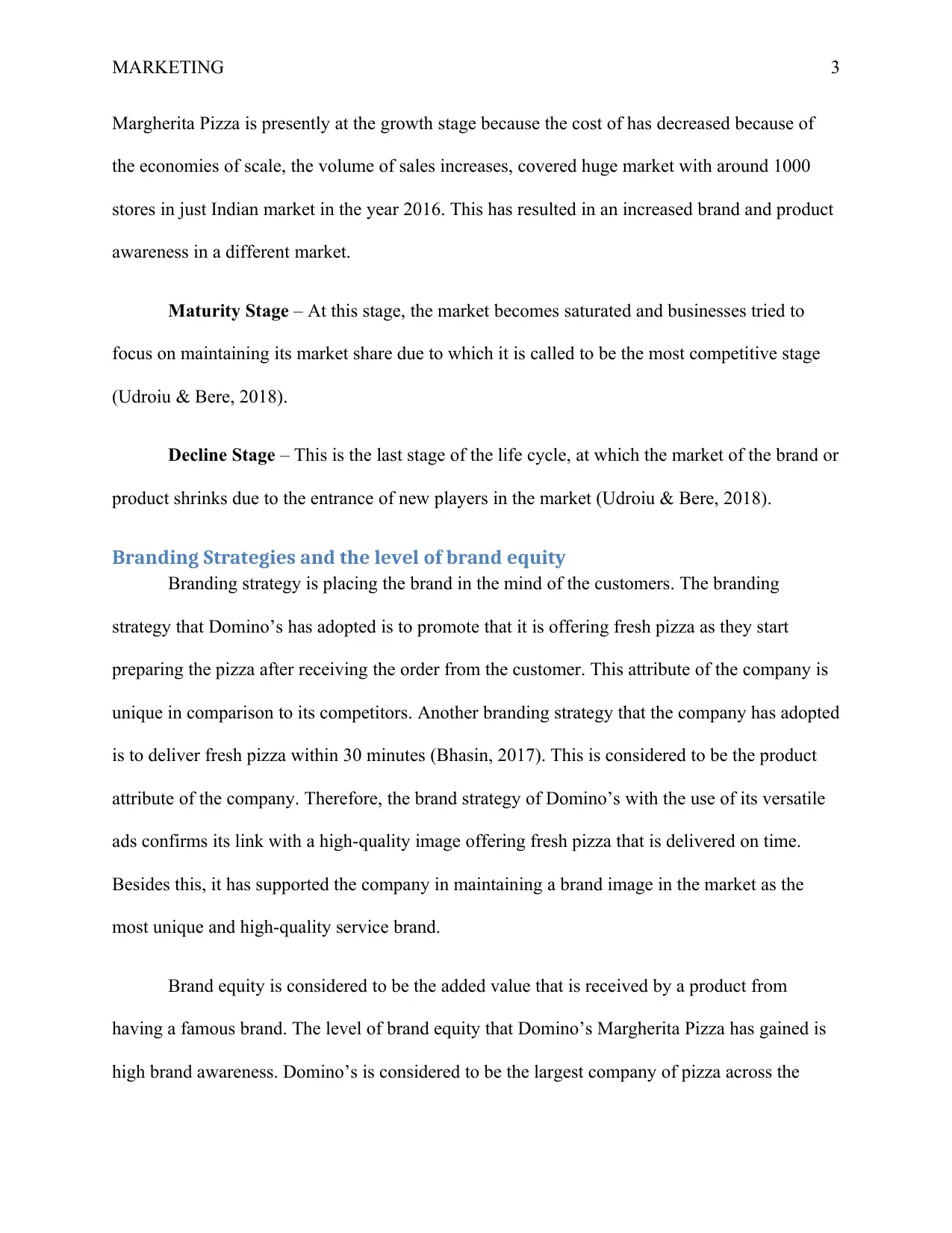
MARKETING 3
Margherita Pizza is presently at the growth stage because the cost of has decreased because of
the economies of scale, the volume of sales increases, covered huge market with around 1000
stores in just Indian market in the year 2016. This has resulted in an increased brand and product
awareness in a different market.
Maturity Stage – At this stage, the market becomes saturated and businesses tried to
focus on maintaining its market share due to which it is called to be the most competitive stage
(Udroiu & Bere, 2018).
Decline Stage – This is the last stage of the life cycle, at which the market of the brand or
product shrinks due to the entrance of new players in the market (Udroiu & Bere, 2018).
Branding Strategies and the level of brand equity
Branding strategy is placing the brand in the mind of the customers. The branding
strategy that Domino’s has adopted is to promote that it is offering fresh pizza as they start
preparing the pizza after receiving the order from the customer. This attribute of the company is
unique in comparison to its competitors. Another branding strategy that the company has adopted
is to deliver fresh pizza within 30 minutes (Bhasin, 2017). This is considered to be the product
attribute of the company. Therefore, the brand strategy of Domino’s with the use of its versatile
ads confirms its link with a high-quality image offering fresh pizza that is delivered on time.
Besides this, it has supported the company in maintaining a brand image in the market as the
most unique and high-quality service brand.
Brand equity is considered to be the added value that is received by a product from
having a famous brand. The level of brand equity that Domino’s Margherita Pizza has gained is
high brand awareness. Domino’s is considered to be the largest company of pizza across the
Margherita Pizza is presently at the growth stage because the cost of has decreased because of
the economies of scale, the volume of sales increases, covered huge market with around 1000
stores in just Indian market in the year 2016. This has resulted in an increased brand and product
awareness in a different market.
Maturity Stage – At this stage, the market becomes saturated and businesses tried to
focus on maintaining its market share due to which it is called to be the most competitive stage
(Udroiu & Bere, 2018).
Decline Stage – This is the last stage of the life cycle, at which the market of the brand or
product shrinks due to the entrance of new players in the market (Udroiu & Bere, 2018).
Branding Strategies and the level of brand equity
Branding strategy is placing the brand in the mind of the customers. The branding
strategy that Domino’s has adopted is to promote that it is offering fresh pizza as they start
preparing the pizza after receiving the order from the customer. This attribute of the company is
unique in comparison to its competitors. Another branding strategy that the company has adopted
is to deliver fresh pizza within 30 minutes (Bhasin, 2017). This is considered to be the product
attribute of the company. Therefore, the brand strategy of Domino’s with the use of its versatile
ads confirms its link with a high-quality image offering fresh pizza that is delivered on time.
Besides this, it has supported the company in maintaining a brand image in the market as the
most unique and high-quality service brand.
Brand equity is considered to be the added value that is received by a product from
having a famous brand. The level of brand equity that Domino’s Margherita Pizza has gained is
high brand awareness. Domino’s is considered to be the largest company of pizza across the
Paraphrase This Document
Need a fresh take? Get an instant paraphrase of this document with our AI Paraphraser

MARKETING 4
world in terms of its retail sales. This has been achieved by the huge investment in the promotion
by domestic and international franchisees (Domino’s, 2020).
world in terms of its retail sales. This has been achieved by the huge investment in the promotion
by domestic and international franchisees (Domino’s, 2020).
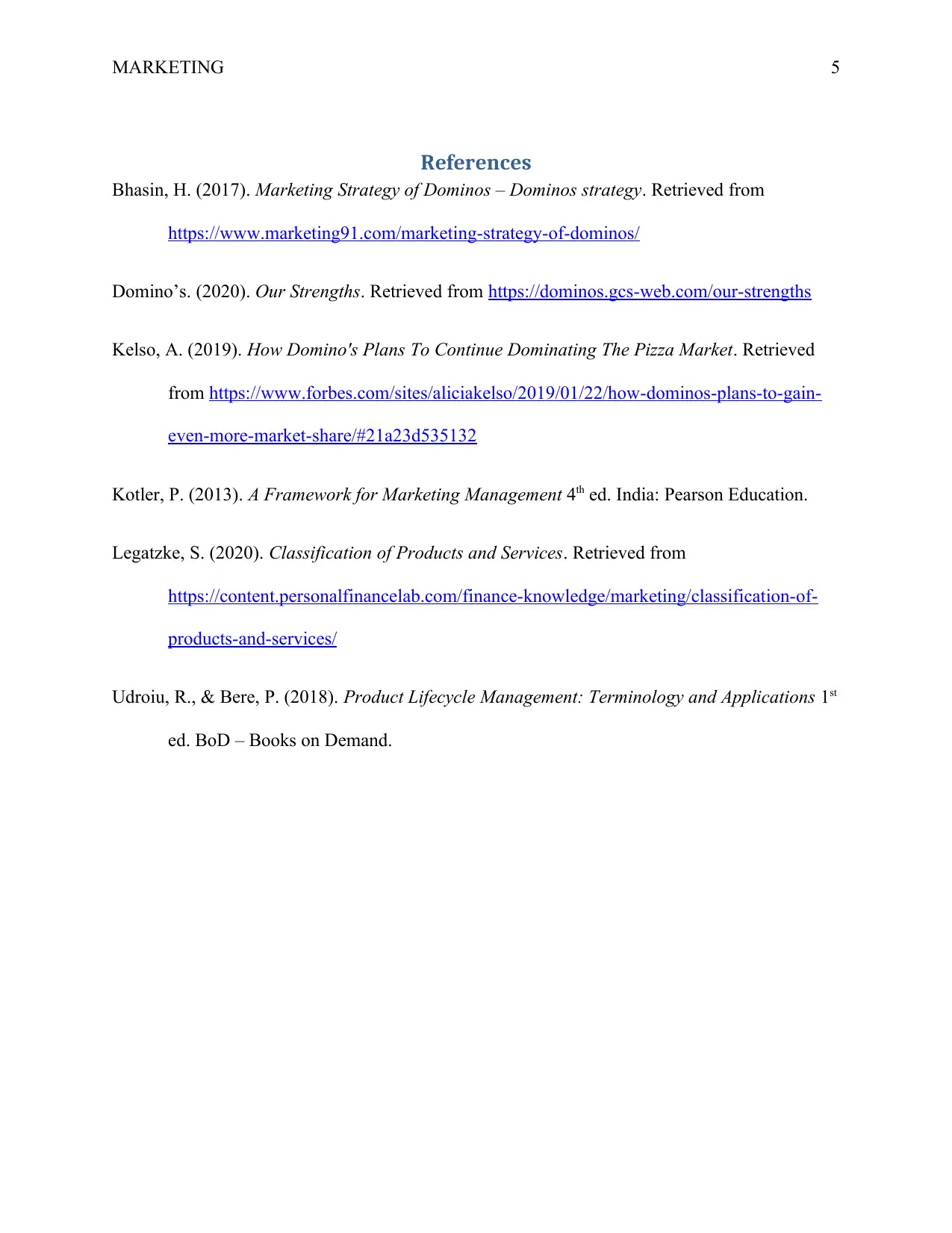
MARKETING 5
References
Bhasin, H. (2017). Marketing Strategy of Dominos – Dominos strategy. Retrieved from
https://www.marketing91.com/marketing-strategy-of-dominos/
Domino’s. (2020). Our Strengths. Retrieved from https://dominos.gcs-web.com/our-strengths
Kelso, A. (2019). How Domino's Plans To Continue Dominating The Pizza Market. Retrieved
from https://www.forbes.com/sites/aliciakelso/2019/01/22/how-dominos-plans-to-gain-
even-more-market-share/#21a23d535132
Kotler, P. (2013). A Framework for Marketing Management 4th ed. India: Pearson Education.
Legatzke, S. (2020). Classification of Products and Services. Retrieved from
https://content.personalfinancelab.com/finance-knowledge/marketing/classification-of-
products-and-services/
Udroiu, R., & Bere, P. (2018). Product Lifecycle Management: Terminology and Applications 1st
ed. BoD – Books on Demand.
References
Bhasin, H. (2017). Marketing Strategy of Dominos – Dominos strategy. Retrieved from
https://www.marketing91.com/marketing-strategy-of-dominos/
Domino’s. (2020). Our Strengths. Retrieved from https://dominos.gcs-web.com/our-strengths
Kelso, A. (2019). How Domino's Plans To Continue Dominating The Pizza Market. Retrieved
from https://www.forbes.com/sites/aliciakelso/2019/01/22/how-dominos-plans-to-gain-
even-more-market-share/#21a23d535132
Kotler, P. (2013). A Framework for Marketing Management 4th ed. India: Pearson Education.
Legatzke, S. (2020). Classification of Products and Services. Retrieved from
https://content.personalfinancelab.com/finance-knowledge/marketing/classification-of-
products-and-services/
Udroiu, R., & Bere, P. (2018). Product Lifecycle Management: Terminology and Applications 1st
ed. BoD – Books on Demand.
⊘ This is a preview!⊘
Do you want full access?
Subscribe today to unlock all pages.

Trusted by 1+ million students worldwide
1 out of 6
Related Documents
Your All-in-One AI-Powered Toolkit for Academic Success.
+13062052269
info@desklib.com
Available 24*7 on WhatsApp / Email
![[object Object]](/_next/static/media/star-bottom.7253800d.svg)
Unlock your academic potential
Copyright © 2020–2025 A2Z Services. All Rights Reserved. Developed and managed by ZUCOL.





